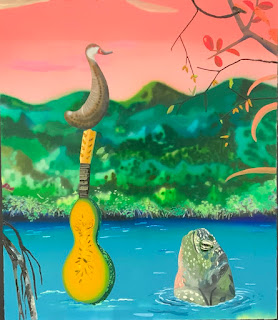A review of Nicole Eisenman : What Happened at the Museum of Contemporary Art Chicago—————————————————————————————————————
Another Green World, 128 x 106, 2015
I don’t enjoy looking at these paintings. In the tradition of social realist murals, their message is delivered at the expense of aesthetics. Figures often suffer monstrous distortion, pictorial space is collapsed onto the surface, and color is crudely chopped up as if to make it printable. You can sense a vigor of design in the small scale of the jpeg shown above. It reminds me of the tumultuous battle scenes in Mughal miniatures. And the celebration of affection and community is truly endearing. But at room size it’s oppressive. I’d probably feel the same way about "The Rake’s Progress" by William Hogarth if it were ten feet long instead of two.
Triumph of Poverty, 2009, 67 x 83"
Eisenman makes clever, gently satirical cartoons. Gladys Nilsson works a similar territory for us Midwesterners. It’s just that cash value is proportional to size in the contemporary artworld - so she makes them way too big. Viewers of contemporary art are used to work that makes them feel disoriented and uncomfortable. I try to avoid it.
Coping, 2008, 65 x 82
This nightmarish scene is somewhat intriguing on my iPad, but oppressive at seven feet across.
Seder, 39 x 48, 2009
This piece is just about the right size - so I can imagine myself reading the Haggadah to an assembled family of gentle folk and misfits, expressively portrayed by the artist. It makes a fine contrast with Norman Rockwell’s Thanksgiving dinner as attended by idealized stock characters. But still — a great painting? No. There is nothing visual here to savor. It’s all about rambunctious disruption. Everyone feels out of place. With each viewing it becomes more stale and tiresome. Like the Sunday comics, it’s disposable.
And that’s what separates Eisenman from Brueghel (whom she quoted in "The Triumph of Poverty".). Pieter Brueghel the Elder’s paintings were great as both cartoon and painting - and that hardly ever happens in blue-chip contemporary art. (Kerry Marshall being a notable exception)
*************************************************
So I’m not going to assert, as Sebastian Smee recently did in the Washington Post, that "Nicole Eisenman is one of the best American painters working right now." Aesthetics still matter - at least to me. Everything else is just subject matter- maybe you identify with it - maybe you don’t.
Smee does, however, make some sharp observations about how Eisenman’s painting has changed over the decades shown in this retrospective.
And we may note some ambivalence in his concluding paragraphs:
Art, at its best, starts from a premise of aliveness. Aliveness (in the forms of humor, sensuality, richness of response) is attached at the hip to awareness. Awareness (the human brain and body liberated from sentimentality, propaganda and all other forms of denial) involves registering the full extent of the debacle. But acknowledging the debacle, in turn, plunges us into depression — the very opposite of aliveness.
Awareness also involves registering the full extent of the miracle - before which we must believe the debacle is just a bump on the road. For those who love the awareness of miracle in form - Eisenman’s paintings are indeed depressing —- the larger they are, the more so.
Something like this dynamic inheres in Eisenman’s work. Her paintings and brilliant sculptural ensembles are atotally alive — sometimes almost maniacally so. But they’re also continually collapsing into a stunned stasis. When they emerge again, it’s into states of bafflement as the artist tentatively gropes after community, which she tenderly, gratefully celebrates.
Yes - stunned stasis is what I’m feeling here - and it’s repulsive - however tenderly community has been embraced. A serious adult public space - like an art museum - should not have the aesthetics of a feel-good daycare center.
BTW - Smee’s essay was quite impressive. If he didn’t pay proper respect to the judgment of the marketplace, he wouldn’t get published. But if he didn’t subtly undercut it, he wouldn’t be an art critic.
******************************************
Nor am I as comforted by these paintings as Annettte Lepique was in New City when she concluded
Abolitionists in the Park, 2020-2022, 10’8" x 8’9"
There’s something moving about this moment.("Abolitionists in the Park") There’s recognition of not just one of those now-ubiquitous blue masks, but also the quiet trust that the sleeper gives to the people around her. There’s the knowledge that the exhaustion you may have felt and feel in the face of the world’s chaos is shared. There’s reassurance that you too are part of this world, that isolation is not the norm; that someone, somewhere shares language in common with your heart.
Unlike those "abolitionists in the park", I had no interest in defunding a police department in the aftermath of the George Floyd homicide. Nor would I conflate them with the indispensable anti-slavery abolitionists of the early 19th century.
So I am not reassured that "someone, somewhere shares language in common with my heart". This is actually a rather small, if vocal, minority of Americans. This, like so much social justice art, is preaching to the choir.
When you ask yourself what did you see, what did you do, what all happened? Know this: everything. Everything happened. You just have to look to truly see it all.
These are fit words to end an essay about a show called "What happened?" - but it’s also a bit of nonsense. Many things did indeed happen — but none of us can ever truly see it all. This painting presents only one point of view.






















